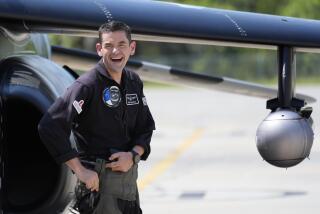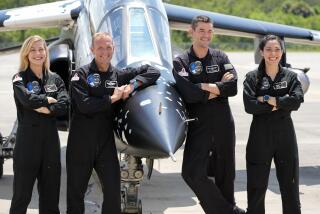Emotion High as NASA OKs Flight of Discovery
- Share via
KENNEDY SPACE CENTER, Fla. — Top space executives gave their formal approval Wednesday for the launching of the Discovery as officials here worked with equal measures of anxiety and elation toward today’s scheduled liftoff.
The launching of the Discovery, set for 6:59 a.m. PDT, will return the United States to the arena of manned space flight for the first time since the Challenger exploded 32 months ago.
“I’m tickled pink to be here,” Rear Adm. Richard H. Truly, head of the shuttle program, told a grandstand full of reporters Wednesday afternoon.
Weather Cooperating
Even Florida’s fickle weather seemed to be cooperating, with light winds and scattered clouds.
Anxiety over the launching ran high among officials who were here in January of 1986 when the Challenger forever changed the course of the nation’s space program. Questions about the possible impact of another disaster were brushed aside with nervous laughter, but there is no hiding the fact that most people here are on edge.
“Just call me Ensign Truly,” the Navy admiral who runs the chuttle program quipped when asked if his career is on the line alongside the lives of the five astronauts who are to be blasted into space aboard the Discovery.
Truly understands better than most what the astronauts are going through as they prepare for spaceflight. He is a former astronaut himself.
He said he had talked earlier in the day with Frederick H. Hauck, 47, commander of the Discovery.
“Rick tells me he and the other members of the crew are elated to be headed for space,” Truly said.
Top officials have said repeatedly that the launching will usher in a “new era” in the U.S. space program, but signs posted all over Florida’s space coast put it perhaps more succinctly. The Discovery, the signs proclaim, will move the nation “back to the future.”
The United States was the world leader in space exploration at the time of the Challenger disaster, but that tragedy plunged the space program into a period of self doubt and despair. A nation that once put men on the moon now waits anxiously for five seasoned veterans to reach low Earth orbit just 184 miles above the ground.
For the thousands of men and women who work in the program, and the millions of others who support it, low Earth orbit will do nicely for now. As Arnold D. Aldrich, shuttle director here at Kennedy, put it:
“Tomorrow (Thursday) the shuttle should return to its proper place in the sky and launch us into a new era.”
After reaching orbit today, the shuttle is scheduled to deploy a $100-million communications satellite. Various science and technology experiments are planned for Friday and Saturday. The astronauts will hold a news conference from the Discovery on Sunday, and on Monday morning the shuttle is expected to touch down at Edwards Air Force Base in California.
Around the Kennedy Space Center area Wednesday, excitement was mounting. Campers and recreation vehicles found good viewing places across the Indian River. Souvenir sellers set up shop. NASA’s visitors’ center sold out of the commemorative envelopes that feature the crew patch.
‘Beginning of Future’
NASA’s deputy administrator, Dale Myers, exulted that “we have been working 2 1/2 years to put the shuttle back in business, and tomorrow is the day we plan to do that. It’s really the beginning of the future for our space program.”
Kennedy Space Center Director Forrest S. McCartney told the Associated Press: “We have to be successful. The nation could not withstand another accident like Challenger.
“You can’t totally take the risk out of something like this,” McCartney said. “But, in those last hours of the count, I’ll know that we have done everything we know how to make this a safe flight, that we have reduced the risks as much as we possibly can.”
Two problems that surfaced in recent days appeared to be resolved.
One had to do with a booster rocket being readied for a twin of the tracking and data relay satellite the Discovery crew is to launch six hours after liftoff. A small sealing O-ring on the booster rocket, destined for flight next February, was found to have a tiny cut--apparently caused by a metal burr.
Rings Tested Overnight
Engineers worked overnight and said tests of rings deliberately flawed showed that they would not leak. They said the cut apparently was inflicted during installation and is not a manufacturing defect.
The other snag involved the scraping off of a layer of paint on one of Discovery’s small jet thrusters used to position the shuttle in orbit. But it was found that underlayers of the thermal paint were intact and that the thruster could be bypassed if need be.
The National Aeronautics and Space Administration has picked some of its most experienced veterans for the flight. All five crewmen have flown before, and all five have flown in the same positions they will hold aboard the Discovery.
In addition to Hauck, the crew includes co-pilot Richard O. Covey, 42, John M. Lounge, 42, David C. Hilmers, 38, and George D. Nelson, 38.
The job they must perform, as Myers put it Wednesday, “is absolutely vital to the future exploration (of space) by mankind.”
More to Read
Sign up for Essential California
The most important California stories and recommendations in your inbox every morning.
You may occasionally receive promotional content from the Los Angeles Times.









